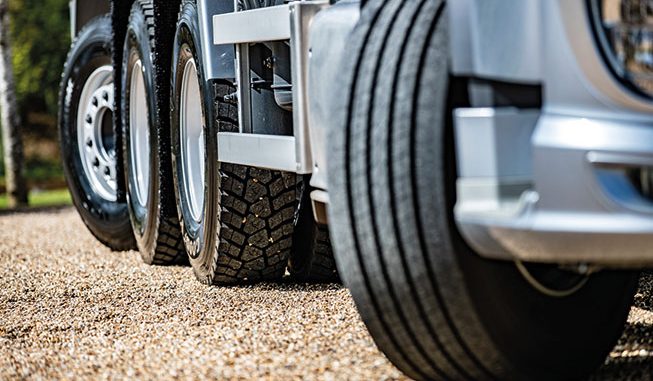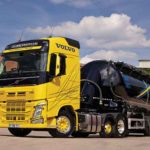
BACK IN 1998 Pioneer Concrete sought to improve the payload and volume of its 6×4 mixers by moving to four axles. Unwilling to go to a conventional 8×4 chassis with its inherent lack of manoeuvrability, it converted a traditional 6×4 carrying a 5cu.m barrel by adding an extra pusher/lift axle in front of the double drive bogie.
Leyland based Drinkwater Chassis Engineering did the conversion, creating a tridem. Plated at 29 tonnes and now fitted with a 7cu.m drum, Pioneer Concrete would convert many more Foden 3325 6x4s into tridems. And as genuine forerunners, Drinkwater Chassis Engineering continued to develop tridem for other concrete suppliers through the early 2000s.
Otherwise the tridem (including ‘tridrives’ which were vehicles with three drive axles) had previously existed as tractor units used for roadtrains in Australia, New Zealand and North America and as heavy-duty construction trucks across mainland Europe and Scandinavia.
And it was Volvo Trucks that officially introduced it to the British market in 2008 with an air-suspended three-axle bogie. By 2011 tridem was popping up on fleets across the UK.
Tridem has evolved as a single and double drive specification and has been adopted by every truck manufacturer including DAF who introduced its first tridem in 2014; FAQ is an 8×2 with one drive axle and three steering axles (TN, September 2017).
Last year DAF Trucks unveiled FAW, an 8×4 with a rear-steer trailing axle, at the CV Show and is available as a CF or XF.
To put FAW’s manoeuvrability into perspective, comparisons with others are made on the outer axle spread being as close to like-for-like as possible. So, for the conventional eight legger with a two-plus-two axle configuration on FAD and FAX it is 6.4m, while the one-plus-three tridem axle configurations puts the FAW at 6.65m and FAQ at 6.45m (see sidebar).
With a 15.4m turning circle, DAF Trucks said ‘FAW was ideally suited for transporting large or heavy loads to sites where there is relatively little space’ and ‘lends itself to operation as a tipper, concrete mixer, for bodywork with a rear mounted crane or for a combination of a loading crane with a hook lift system’.
The FAQ has established itself as something of a niche within a niche market, but is recognised as an ideal solution for bulk agricultural deliveries and refuse collection on hard surfaces.
Production has more than tripled in numbers in just two years to 34 so far this year.
Yet despite three steering axles, its turning circle (kerb-to-kerb) is 18.4m, which is 3.0m more than the FAW. This is due to the FAQs steering drag link between the first and second steer axle being too close to the shock absorbers, so the front axle steering lock is limited to 43 degrees.
The tridem is best viewed as a six-wheeler with added payload rather than a replacement for a traditional 8×4, which in DAF’s spec line-up is the FAD that has a 20.3m turning circle. That is 4.9m wider than the FAW.
And there is FAD’s single drive axle version the FAX, an 8×2 with a rear-steer axle. Its turning circle is also limited by the same drag link problem but it’s slightly better than the FAQ.
Another item of interest is that the FAW is available with a wider choice of specification than the FAQ, most notably the XF cab in addition to the CF. This demo truck features the XF Comfort cab, DAF’s take on the low-roof but otherwise full-size sleeper cab concept.
While it looks a bit like a chopped roof custom car from outside, there’s enough space around the driving position to prevent any claustrophobic feelings. Despite it appearing to have no space above the windscreen, there is actually room for a couple of handy storage lockers.
The engine hump is only around six inches high, and while there is never going to be enough room to stand up straight, there is certainly enough to move around or get dressed without too much stooping. The bunk height is ideal for sitting comfortably without bending your neck. With storage under the bunk, there’s plenty of space for a few days away.
On the test route, the Comfort cab is ideal. On road, laden to within a whisker of 32 tonnes, it must be said that it doesn’t have the feeling of raw power that you might expect from a 480hp rated engine.
The power delivery is soft but effective, and following the down-speeding trend, digs in well to an unfeasibly low engine speed, 850rpm. The test truck’s 24 tonne rear bogie was fitted with the 2.83:1 axle ratio, the second fastest of the nine on offer.
There’s plenty of scope to create more pulling power in more arduous terrain. There was no evidence that the engine running on green HVO diesel had any adverse effect on performance.
ROLL STIFFNESS
The off-road section at the Whitecliff 4×4 site by the quarry provided plenty of opportunity to evaluate the handling of DAF’s tridem tipper and it was impressive. There was little evidence of the three axles overcoming the single front one, although on a couple of occasions we felt there could be a bit more roll stiffness at the front.
Fully laden, the ride was exemplary, and if the steel parabolic front springs were to transmit any bumps, they’d still have to get through the air-suspended cab and luxury seat to reach the driver. An opportunity to discover how the new 10 tonne front axle copes when empty, would have been welcomed. It has the potential to get a bit lively, but that aspect must wait for another day.
One thing that is certain, though, is that the FAW’s biggest selling point, the manoeuvrability of a 6×2 with the capacity of an 8×4, is a real benefit. On paper, where you have to measure in millimetres to discover that the FAW has a turning circle marginally better than DAFs FAT 6×4, and in towns which feature plenty of near hairpin junctions, the reality was proven. To put it into perspective, if you did a full-lock U-turn in a regular FAD 8×4, then followed in an FAW, you could easily overtake the traditional chassis on the inside.
To complete the picture, we took the FAW off-road in an abandoned quarry, now only used for 4×4 activities. Here, the twin virtues of this example were tested. The low-roof of the otherwise big cab made it much easier to negotiate the numerous low-hanging branches, while the full-size tipper chassis handled the numerous tight bends with ease.
That the 12-speed TraXon’s on-highway performance is excellent is a given, but it proved equally capable off-road. Most of the time, it was perfectly happy to stay in auto, but if the need to maintain manual control becomes apparent, this is a finger-flick away on the right-hand column stalk. The MX engine brake provided enough control finesse to deal with most of the off-road descents while leaving the service brakes in reserve for the trickier bits.
While DAF may have taken its time to fill this particular niche, it has done it well and now has a complete range of boxes to tick to meet almost every operational need.




